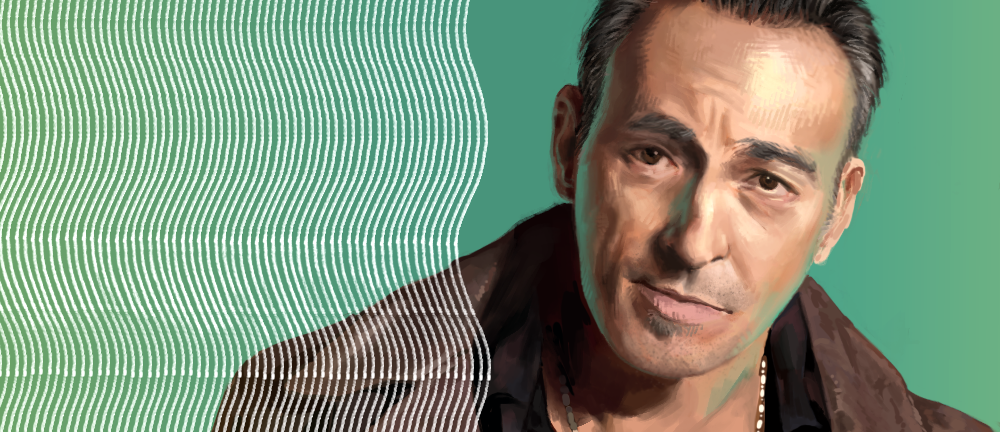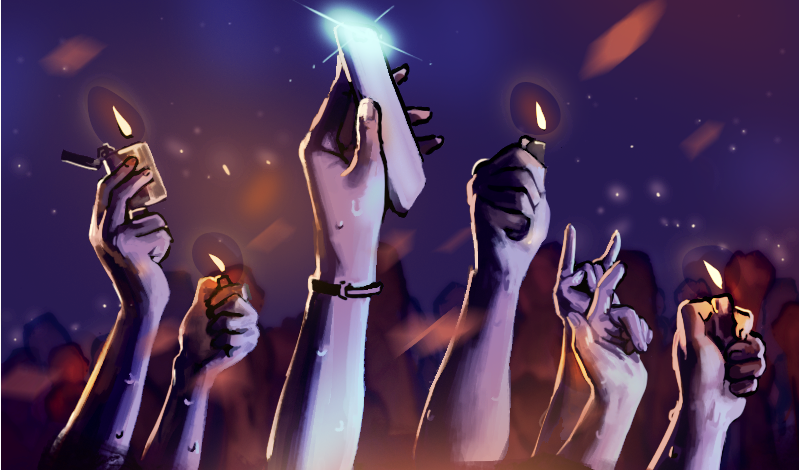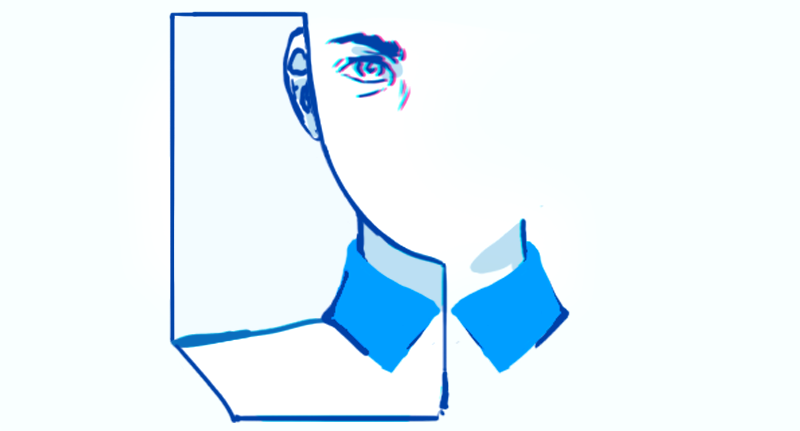I am not a religious man, by neither temperament nor upbringing, but I did, once, come close to experiencing the sort of transcendence of the self that the world’s great spiritual traditions speak to. In my case though, it was not in a church, a synagogue or a mosque, nor was it retracing the steps of ancient pilgrimage or flying through the stars on a proscribed substance. Rather, my encounter with the essential interconnectedness of our selves and the universe came on a nipping cold March evening on the far outskirts of Ottawa. In one of the cheaper corners of the then-Scotiabank Place, now-Canadian Tire Centre, along with the rest of that sold out stadium, I would be moved by a three hour a set of stories and experiences that spanned the highs and lows of humanity. From rollicking, juvenile triumph to sober, resigned reflection and back again, with some stops for muscular calls for social healing and jokey, upbeat romances along the way. It was the first and thus far only time I saw Bruce Springsteen, complete with as many surviving members of the E Street Band as he could marshal, in concert.
Tributes to the power of rock concerts in general, and to Springsteen’s shows in specific, are now a well-worn idiom of music writing that has likely been squeezed dry of any new insight and this is not an essay about that, at least not exclusively. For myself, as someone raised on Springsteen’s music but too young to have experienced his most fertile creative period first-hand, attending that concert was something of an end to a personal journey that began before I even knew who he was. It was, and remains, a journey just as much about my personal definition of what it means to be a good person, and a good man more specifically, as it is about Springsteen’s music. What I saw that night may not have been the absolute peak of Springsteen’s powers, but it was a peak in terms of personal connection to an artist. (I’m sure someone who saw a classic 1970s show might have found it lacking.) Though I was well up into the cheap seats, it was easy to feel that this had been a show put on just for my benefit. A Springsteen concert is a famously extended affair, often lasting over three hours and with no opening act, where both performer and audience are sure to be soaked in at least a thin layer of sweat before the night is over. For me, on that night, it was communion with a spirit that led me to become who I am today.
“Talking ‘bout the Weekend, Scrubbing Off the Dirt”
Springsteen’s voice was always one of the most distinct that came crackling through my father’s radio as I sat in the passenger’s seat on seemingly endless car rides on the 401 or backroads in Northumberland County. His vocal style has sometimes been described by skeptics as melodramatic or overwrought, but, even at that young age, it seemed to say something more to me than most of the other classic rock that got featured. Even if one could not make out exactly what it was this man was singing about, as I surely could not at the time, that voice demanded to be noticed by its very intensity. “This is important, this is real life”, it seemed to be saying, even as the surface-level lyrical indicators were not much different from disposable tributes to cars, girls, and girls in cars that made up a good bulk of the music which surrounded it. Pumped up by the widescreen theatrics of the music, there seemed to be a genuine struggle that powered this man, a primal need to express himself that the recording equipment just so happened to capture.
Of course, this appearance of spontaneous urgency is, in fact, a well-labored illusion. Springsteen is known for meticulously composing and reworking his material until it achieves a just-so, mercurial quality. The mixing process of “Born to Run” nearly drove him to a nervous breakdown in search of perfection, until he gave up and released a mix he considered a half-finished as a single. Its wild-gossamer sound provided his popular breakthrough. It takes a lot of effort, in other words, to sound as chaotic and full of unbridled energy as classic-period Springsteen did.
As is common for most rural-to-suburban teenage boys, I had a Led Zeppelin phase in middle school, followed by an intense interest in heavy metal and grunge, and then settling on punk and post-punk in late high school. Throughout all those changes in my taste, I kept coming back to Springsteen, getting reissues of his classic records for Christmas and loyally buying the two new albums (2007’s Magic and 2009’s Working on a Dream) that came out when I was in high school. Though my interest in each individual project would wax and wane depending on which elements of his sound he chose to place emphasis on, I always kept the classic records (an unparalleled run which goes from 1975’s Born to Run to 1984’s Born in the USA) close at hand. When other musicians, indeed when other role models, seemed to fail me, Springsteen was always there, guitar in hand and empathic words in the throat. I can’t speak to the impact those records had upon their initial release, but I do know that, for me, as I ventured out into the world beyond the small town I grew up in, they were a kind of guidebook for life. The stories on those records of getting out into the street after a hard week’s work, of arguing with uncaring father figures, of putting up a strong face to the adversity of the world, resonated across time and social context in a way few others did.
“May Your Strength Give Us Strength”
Springsteen is often pegged as representative of a particular kind of Boomer nostalgia for a time when men were men, women looked great lounging on the hoods of cars and rock-and-roll ruled the airwaves. In a certain sense, this is an easy characterization to make, given the reference points his music draws from and his scruffy, salt-of-the-earth image. It is easy to wonder if there isn’t a bit of a reactionary angle to some of the worship of the man as a sort of avatar for the hopes and aspirations of America’s white working class. Certainly, a mass survey of Springsteen’s audience would likely turn up the same sort of prejudices as any disproportionately older, whiter, more male slice of the population.
At the same time, listening to Springsteen’s music carefully quickly throws these notions into question. For starters, Springsteen’s music is “rock” only in the sense of its chosen idiom, being quite apart from basic three-chord meat-and-potatoes classicism. Trying to describe the set of influences which Springsteen brings to the table is something of an impossible task, taking in as he does influences from almost every strain of American music which predates him. Certainly, there is early, Chuck Berry/Elvis Presley rock as a foundation, along with the folk-poetics of Bob Dylan, the chugging rhythms of Motown R&B and the muscular, blues-based swagger of the Rolling Stones. At the same time, the expansive instrumentation and intricate composition of his songs owe more to Brill Building pop and West Side Story than they do the stripped-down guitar music. Later on, Springsteen’s palette would expand to incorporate Dust Bowl country and traditional Celtic folk (2006’s The Seeger Sessions), and even hints of new wave (“My Hometown”) and hip-hop (“Rocky Ground”). It was and remains a remarkable feat that Springsteen and his E Street Band were able to corral this unwieldy set of ideas into music that is not only coherent and cohesive but wildly popular.
Lyrically, it would be fair to say that Springsteen is a masculine writer, concerned primarily with the experiences of men. This is not to say that his character portraits of women are not empathetic or nuanced (see: “Candy’s Room”, “Reason to Believe”), but rather that the main characters of his songs are by-and-large male and by-and-large exist within a normative understanding of what that means. Much of the ability that many have to relate to Springsteen’s music comes from the way in which he invests the every day with a near-magic realist sense of drama (“there’s an opera out on the turnpike/there’s a ballet being fought out in the alley”). However, if Springsteen’s world is masculine one, it is also which is deeply empathetic, interested in the complexity of the emotions these men feel and how their own sense of themselves can be just as much entrapping as it is liberating. After all, what other classic rockers would write songs that sympathetically explore both sides of a strained father-son relationship (“Adam Raised a Cain,” “Independence Day”)? Or seem to directly respond to one of their biggest hits with a downcast ballad which directly questions the American mythology of the car as a source of liberation (“Racing in the Street”)? Even a simpler, let’s-get-out-of-town number like “Sherry Darling” is complicated by familial attachment and poverty (the protagonist of the song drives his girlfriend’s mother to the welfare office in the first verse). In contrast to a lot of his contemporaries, the men in Springsteen’s songs are not two-dimensional creatures on the hunt for booze, babes and good times.
Springsteen’s exploration of masculinity comes through the strongest on 1987’s Tunnel of Love, his underrated follow-up to Born in the USA. Written and recorded during the breakdown of Springsteen’s first marriage, it is one of the most thorough and sustained investigations of the strains love and commitment on record. The songs range from solemn declarations of commitment despite hard odds (“Tougher Than the Rest”) to dissections of the psychology of doubt surrounding the essential unknowability of a romantic partner (“Brilliant Disguise”). Though the album’s sound, with heavy use of synthesizers and drum machines, does remain distinctly colored by the era in which it was released, the underlying emotional truths that it speaks to remain more timeless. Love is the ultimate journey into the dark on the album’s title track, made so by the narrator’s carrying “all that stuff I’m so scared of” along with him. What that package exactly contains, the listener can only speculate, based on what we know the prototypical Springsteen protagonist to be.
“Trade in These Wings on Some Wheels”
Aside from that reflection of the personal, Springsteen’s music, with its slamming polyglot of influences and textures played by a multi-ethnic, mixed-gender orchestra of the street corner, seems to promise a kind of eternal social reconciliation. It seems to hold out the possibility that all social conflict may ultimately be illusory, wedges stuck between us by the forces of “boss men” and outdated tradition. That sense of hope and optimism of a peculiarly American kind, the faith that a grand social experiment will, indeed, fulfill its promise in the fullness of time, is something that powers event the darker moments of his catalog.
This is the Springsteen whose 2002 album The Rising was such a late-career touchstone, with its touching tributes to the victims and first responders of 9/11 (“Into the Fire”) leavened by songs which found comfort in resilience (“The Rising”) and newfound community spirit (“Mary’s Place”). Even there, though, he refused to go in for jingoistic reaction, bringing in supporting Middle Eastern musicians for one track (“Worlds Apart”) which, albeit through a clumsy relationship metaphor, reached across cultures for common humanity. It is little wonder, then, that Springsteen enthusiastically stumped in both 2008 and 2012 for the Obama campaign, often playing solo acoustic sets at rallies. Obama’s social pitch to the American people was remarkably akin to the vision that the E Street band sketches out on stage every night they play. The notion divides, both partisan and racial, could be transcended by an emphasis on what was shared, which Obama later sharpened in the 2012 campaign into a critique of at least the most extreme, antisocial sections of capital, was certainly an appealing one. It’s hard to say if Springsteen’s endorsement of Obama directly secured anyone’s vote, but it is certainly possible to see more than a few hard-up Rust Belt residents being reassured in their choice by the gesture.
In the colder light of 2018, of course, such a vision can appear painfully naïve at best, and glibly condescending to the socially marginalized at worst. At the same time, Springsteen’s politics are not all gauzy, liberal tributes to the indomitable American spirit. Particularly in his later albums, and in his folk material more influenced by the likes of Woody Guthrie, there are genuine villains, familiar to those of a progressive political bent. In these songs, modern robber barons destroy communities (“Death to My Hometown”), undocumented immigrants are brutalized by police (“Balboa Park”) and racialized poverty goes unaddressed through generations (“Black Cowboys”). Perhaps the clearest, and most controversial, example of this comes in “American Skin (41 Shots)”, originally penned as a furious reaction to the NYPD shooting of Amadou Diallo, and later repurposed to pay tribute to Trayvon Martin and Michael Brown. Though it would certainly be a stretch to call Springsteen some kind of socialist, he nevertheless knows that the American canon from which he draws is one that came to him through centuries of bloodshed and conflict. Lest it be forgotten, Springsteen is the man who demanded that Ronald Reagan stop playing “Born in the USA” (despite its rousing chorus, an economically abandoned Vietnam veteran’s lament) at rallies, lest he be seen as endorsing the politics of a man whose America he saw as increasingly cruel and venal.
A reclamation of what could be called the radical Springsteen, champion of the underdog and scourge of the unfeeling late capitalist, has been apparent in the world of indie rock for a number of years. Most prominently, acts like The Arcade Fire have updated the E Street band’s communal swagger with a dark paranoia fit for the digital age. Elsewhere, bands like the Hold Steady use a Springsteen-inspired classic rock sound to tell more distinctly millennial stories about bad acid trips at music festivals and drinking through the afternoon on apartment balconies. Most radically, the majority-Latinx punk band Downtown Boys have, drawing on their skillful incorporation of the saxophone, paid tribute to Springsteen by incorporating a rollicking cover of “Dancing in the Dark” as a staple of their live sets (and as a bonus track on their debut album, entitled, ahem, Full Communism). The band’s frontwoman, Victoria Ruiz, explained her love for Springsteen, despite his milquetoast reputation, by saying that, “he continues to fight for a true exploration of classism and blue-collar pain and angst and ennui.”
For all the working-class power bona fides in Springsteen’s music, though, I still come back to the men that populate the stories he tells. In many ways, they are traditional masculine archetypes, guys who work physical jobs during the day and burn rubber in big cars at night, but they are also so much more. By turns, they are sensitive, loving, defeated, angered, worldly enough to know they cannot speak for everyone but trying to better their empathy nonetheless. With the modern search for a model of masculinity which is untainted by toxicities of misogyny, homophobia, and other forms of bigotry, the greatest hope that the men in Springsteen’s songs give us is that this is possible. They are still distinctly masculine, but in a way that allows in complexity of feeling, solidarity with those different from them (not for nothing was Springsteen drafted to write and perform the title song to Philadelphia, the first mainstream American film to deal sympathetically with the AIDS crisis) and loving, loyal connection to their families and communities.
In short, the Springsteen man, if not necessarily Bruce Springsteen himself, is someone I keep aspiring to be. •
Images illustrated by Barbara Chernyavsky.







